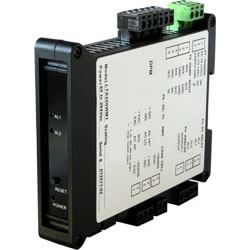
MLT-FR | 4-20 mA & Serial Data Output | Frequency, Rate, Speed | DIN Rail Transmitter
The Micron Meters 4-20 mA and RS232/RS485 transmitter for frequency, rate or period accepts two independently scalable input channels from a wide range of pulse sources, such as NPN or PNP proximity switches, contact closures, digital logic, magnetic pickups down to 12 mV, or AC voltages to 250 Vac. Input frequencies can range from 0.005 Hz to 1 MHz. Applications include AC line frequency, RPM or speed from proximity switch inputs, and flow from turbine flow meter inputs.
- With a Standard Main Board, the transmitter output can be scaled to track frequency in Hz, rate (such as gallons per minute), or period (inverse of frequency). Square root extraction is standard.
- With an Extended Main Board, the transmitter output can track rate or totalized rate (such as gallons) whether the transducer output is linear, requires square root extraction, or requires custom curve linearization. The latter can be provided by a curvilinear spline fit with up to 180 data points. The transmitter can also count up to a preset total or down from a preset total to zero. Such applications typically make use of optional dual solid state relays, which are available as options. External reset of totals is via a special three-position screw terminal connector. The two input channels A & B can also be combined arithmetically to provide an analog transmitter output that tracks A+B (e.g., sum of two flows), A-B (e.g., difference of two flows), AxB (e.g., horsepower as product of force and RPM), A/B (ratio of two flow), and A/B-1 (draw or relative elongation of material between rollers).

Exceptional Accuracy and Stability. Micron pulse input frequency and rate transmitters determine frequency by taking the inverse of period as measured with a calibrated quartz crystal time base. This results in extremely accurate and stable 6-digit internal readings (±999,999 counts), which are then processed in software. The analog output is generated by an ultra-linear 16-bit (65,536 step) digital-to-analog converter (DAC) for 0.02% output accuracy.
The update rate of the transmitter output is a programmed gate time + 30 ms + 0-2 signal periods. For a 60 Hz signal, the update rate would be 20 per second. Such fast update rates are ideal for alarm and control.
Standard features of Micron MLT transmitters include:
- 4-20 mA, 0-10V or -10V to +10V analog transmitter output, isolated, jumper-selectable and user scalable. All selections provide 16-bit (0.0015%) resolution of output span and 0.02% output accuracy of a reading from -99,999 to +99,999 counts that is also transmitted digitally. Output isolation from signal and power grounds eliminates potential ground loop problems.
- Serial communications output, RS232 or RS485 (half or full duplex), jumper selectable. Three protocols are user selectable: Modbus RTU, Modbus ASCII, or Custom ASCII. Modbus operation is fully compliant with Modbus Over Serial Line Specification V1.0 (2002). The Custom ASCII protocol is simpler than the Modbus protocol and is recommended when all devices are Micron units.
- Dual solid state relays, isolated, for alarm or control. Rated 120 mA at 130 Vac or 170 Vdc.
- Transducer excitation output, isolated. User selectable 5V@100 mA, 10V@120 mA or 24V@50 mA.
- Universal 85-264 Vac power. Low-voltage 10-48 Vdc or 12-32 Vac power is optional.
Easy Transmitter programming is via the Instrument Setup Software, which runs on a PC under MS Windows. This software can be downloaded from this website at no charge. The required transmitter-to-PC interface cable is available. (P/N CBL04).
![]() MLT-FR Frequency Rate, Speed Transmitter | Support Library
MLT-FR Frequency Rate, Speed Transmitter | Support Library
Data Sheet | User Manual
